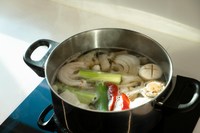
Chicken Broth
Avoid low-sodium broth if you are a GLP-1 or post op surgery, since you lose significant sodium post-surgery. Once you have stabilized your weight, we want you to have a low sodium broth. This simple homemade stock is nourishing, inexpensive, and flavorful—and smells amazing.
Makes about 4 cups of richly flavored broth.
Ingredients
-
Roasted chicken bones (backbone, ribs, pygostyle/"pope’s nose")
-
4 cups water
-
1 bay leaf
-
~9 peppercorns (or ½ Tbsp ground pepper)
Instructions
-
Prepare the bones: After roasting a whole chicken, reserve the bones including the backbone and "pope's nose" (a rich, fatty section).
-
Roast if needed: If bones aren’t already roasted, place them in a pan on medium heat, turning until they’re golden and fragrant.
-
Simmer: Transfer bones to a stockpot, add 4 cups of water, bay leaf, and pepper. Bring to a boil, skimming off any foam that rises.
-
Finish: Once foaming stops, reduce to a simmer and cook for 30 minutes. Strain the stock into a clean container. Discard the bones.
Storage Tips
-
Short-term: Store in jars in the fridge with a layer of fat on top—good for up to five days.
-
Long-term: Freeze in ice cube trays, then vacuum-seal the cubes—keeps for up to one year and makes quick soup bases.
Notes & Context
-
Named the “Post-Op Chicken Broth” because healing requires both energy and sodium.
-
The pope’s nose (pygostyle) adds great flavor in roasted birds—though some chefs remove it for bitterness, it’s valuable in this stock.
-
Myth-busting: bone broth isn’t magical—chicken collagen doesn’t replace essential amino acids. For most purposes, a simple stock is just as effective and a lot more economical.
